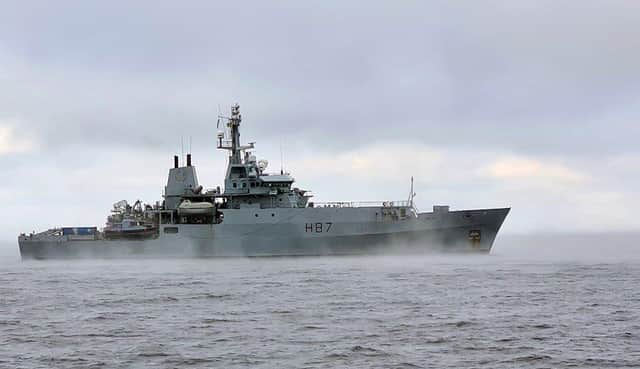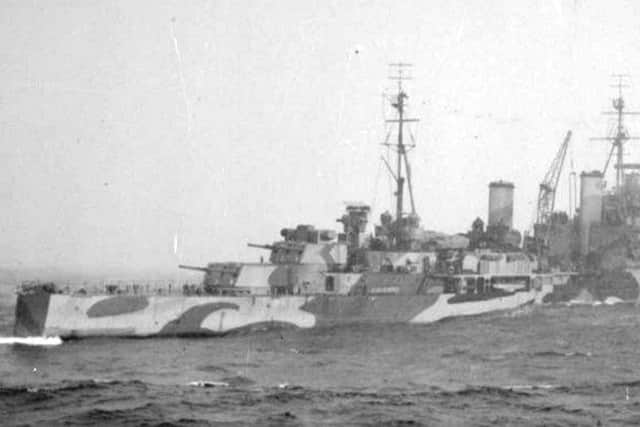Royal Navy pays tribute to Arctic convoy where sailors faced Nazi bombers 80 years ago


HMS Echo paused in the middle of the Barents Sea, located off the northern coasts of Norway and Russia, to remember those involved in Operation Dervish in delivering vital aid to the Soviet Union between 1941 and 1945.
The heroic Arctic Convoys crews delivered between 3.5 and four million tons of cargo of all kinds, including aircraft and tanks, on the trips.
Advertisement
Hide AdAdvertisement
Hide AdSome 3,000 seafarers lost their lives on the journeys and one in every 20 vessels taking on the route sank.


Following a long campaign by The News, the convoy members were finally recognised for their heroism and presented an official medal for their exploits, almost 70 years later.
Devonport-based Echo has been conducting survey work in the sea including searching for the wreck of sunken Second World War cruiser HMS Trinidad.
The crew also gained important information on HMS Edinburgh - where Echo’s crew held a service of remembrance over the wreck.
Advertisement
Hide AdAdvertisement
Hide AdCommanding Officer, Commander Adam Coles, cast a wreath into the ocean as nearby Russian cruiser Marshal Ustinov signalled the vessel in admiration.
Hydrographic specialist Able Seaman Cameron Siddall said: ‘It has been fascinating learning about the history of the Arctic Convoys, particularly as HMS Echo operated in the very same waters that were traversed by the brave merchantmen and warships 80 years ago.’
Petty Officer Calvin Spencer’s great uncle was an 18-year-old sailor aboard destroyer HMS Matchless which rescued six sailors from the German battlecruiser Scharnhorst on Boxing Day in 1943.
‘Seeing the conditions up here myself, during the summer months, without even being under the threat of enemy attack, I can only imagine the horror the brave sailors from both sides went through,’ he said.
Advertisement
Hide AdAdvertisement
Hide AdEcho used sensors to conduct the first survey of the wreck of HMS Edinburgh in 40 years. The cruiser was scuttled in May 1942 after a German submarine blew apart her stern as she carried gold back to Britain.
Weather conditions and the depth of the wreck – 245 metres down – meant that although the wreck was clearly identifiable, finer details could not be found.
The survey vessel also spent 32 hours looking for cruiser HMS Trinidad, also lost in May 1942.
Trinidad is thought to lie 440 metres down but could not be found.
Advertisement
Hide AdAdvertisement
Hide AdCommander Coles added: ‘While the search for Trinidad was ultimately inconclusive, it was still a good chance to utilise Echo’s survey equipment.
‘The wreck investigation on HMS Edinburgh proved a chance to gain valuable data, as well as to remember an important part of the Royal Navy’s heritage, including commemorating the many people who lost their lives during the Arctic Convoys.’
SEE ALSO: Destroyer leaves city for testing
A total of 16 Royal Navy warships were lost and 1,944 senior service personnel were killed, while 85 of the 1,400 merchant ships which took part in the Arctic runs were sunk, killing 800 merchant sailors.
They delivered four million tonnes of supplies to the Soviet war effort – about one quarter of the total aid they provided to the USSR between 1941 and 1945.
Advertisement
Hide AdAdvertisement
Hide AdThe 7,000 aircraft and 5,000 tanks, plus trucks, cars, fuel, medicines, metals and other raw materials helped the Soviets to defeat the Germans on the Eastern Front.
A message from the Editor, Mark Waldron
You can subscribe here for unlimited access to our online coverage, including Pompey, for 27p a day.
Comment Guidelines
National World encourages reader discussion on our stories. User feedback, insights and back-and-forth exchanges add a rich layer of context to reporting. Please review our Community Guidelines before commenting.
